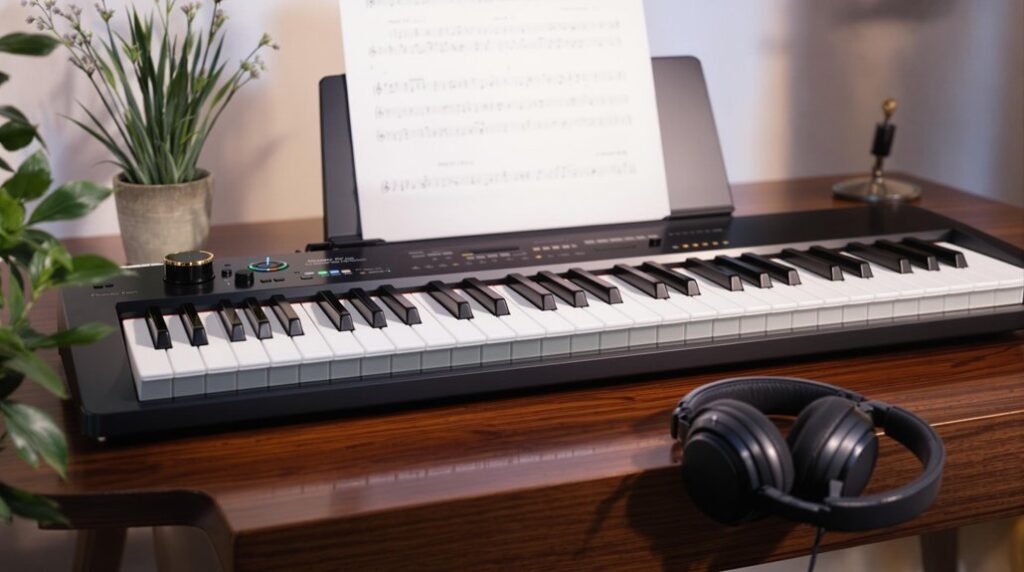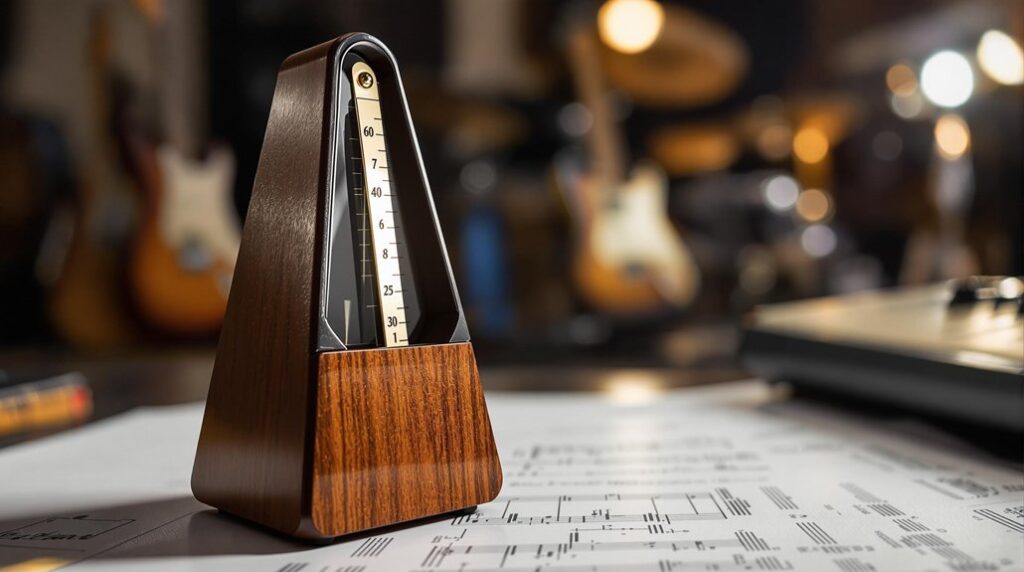A dotted note in music extends a note’s duration by adding half of its original value. This simple addition increases rhythmic complexity and enriches musical expression. You’ll find a small dot positioned to the right of the note head, indicating this extension. There are variations such as double and triple dots, each further extending the note’s duration with increasing complexity. Historically, dotted notes have evolved from medieval notation practices, adding nuanced timing to compositions. Mastering dotted notes can notably improve your rhythmic accuracy and performance skills. If you’re interested in exploring further, there’s much more to uncover about their influence on music.
Key Takeaways
- Dotted notes extend a note’s duration by adding half its original value.
- A dot placed to the right of the note head signifies this extension.
- They introduce rhythmic complexity and enrich musical expression.
- Mastery of dotted notes is essential for accurate and nuanced performances.
- Double and triple dotted notes further increase rhythmic intricacy.
Understanding Dotted Notes
Understanding dotted notes is essential for any musician aiming to master rhythmic complexity and achieve expressive phrasing in their performances.
When you encounter a dotted note, you’re dealing with a note whose duration has been extended by half its original value. This alteration adds layers of rhythmic interpretation and demands precise musical phrasing. For instance, a dotted quarter note, which typically equals one beat, now lasts for one and a half beats, introducing a nuanced delay that can enhance dynamic expression.
Mastering dotted notes allows you to navigate intricate rhythmic structures, making your performances more compelling.
Whether you’re playing a dotted whole note, half note, quarter note, or even smaller subdivisions like eighth and sixteenth notes, understanding their impact on timing is vital. These notes challenge you to maintain accuracy while contributing to the overall rhythmic complexity of a piece.
Historically rooted in medieval music, dotted notes have evolved into a fundamental element of music theory, enriching the rhythmic diversity and expressiveness of compositions.
Visual Representation
When you come across a dotted note, you’ll notice a dot placed to the right of the note head, a key visual indicator extending the note’s duration. This extension alters the timing, adding half the note’s original value, which is important for maintaining rhythmic accuracy.
Understanding the placement rules and symbols for whole, half, quarter, eighth, and sixteenth notes guarantees you interpret the music correctly.
Dotted Note Symbols
In music notation, a single dot placed to the right of a note head signifies that the note’s duration is extended by half of its original value. This simple yet potent symbol can transform rhythmic patterns and add a layer of complexity to musical compositions.
By altering the length of notes like whole, half, quarter, eighth, and sixteenth notes, dotted notes introduce subtle variations that can significantly impact the overall feel and flow of a piece.
Consider how dotted notes contribute to tempo variations and rhythmic complexity. When you see a dotted quarter note, for instance, it lasts as long as a quarter note plus an additional eighth note. This alteration creates a unique rhythmic pattern that can challenge your timing and precision, forcing you to pay close attention to the nuances in the piece.
Incorporating dotted notes effectively demands a keen understanding of how they adjust the note’s duration. Mastering their use will enable you to navigate intricate rhythms and bring a richer texture to your performance.
Duration Extension
To grasp how dotted notes extend the duration of regular notes, let’s examine a visual representation that clearly illustrates this rhythmic adjustment. A dotted note increases its duration by adding half of its original value. This extension allows for greater rhythmic nuances and enriches musical expression.
Here’s a table to show the duration of different dotted notes:
| Note Type | Duration Extended (with dot) |
|---|---|
| Whole Note | 6 beats |
| Half Note | 3 beats |
| Quarter Note | 1.5 beats |
| Eighth Note | 0.75 beats |
| Sixteenth Note | 0.375 beats |
When you add a dot to a note, it’s important to understand and interpret these extensions accurately. A dotted quarter note, for instance, isn’t just a quarter note anymore; it demands rhythmic accuracy to play its full 1.5 beats. This precision is essential for achieving the intended rhythmic nuances and overall musical expression.
Placement Rules
Placing the dot precisely to the right of the note head, avoiding bar lines for clear musical notation, is essential. The dot’s position is pivotal because it directly impacts the note values, altering the duration of the note by adding half of its original value. This specific placement helps musicians interpret the rhythmic timing accurately and consistently.
When you place a dot on a note, it should never cross a bar line. Bar lines separate measures and define the structure of a piece. Placing a dot across these lines can cause confusion in rhythmic interpretation, leading to potential errors in musical timing. Dots must always stay within the same measure as the note they modify to guarantee proper rhythmic accuracy.
Precisely placing the dot ensures that the duration of the note is clear and unambiguous. For example, a dotted quarter note in 4/4 time extends its duration by an additional eighth note, making it last for one and a half beats. Such precision in the visual representation of rhythmic elements is fundamental in maintaining the integrity and flow of musical pieces.
Varieties of Dotted Notes
You’ll find that dotted notes come in several varieties, each extending the duration of its base note—whether it’s a whole, half, quarter, eighth, or sixteenth—by half its original value. This extension plays an essential role in rhythmic patterns and musical analysis, as it alters the timing and flow of a piece.
For instance, a dotted quarter note, commonly found in 4/4 time, lasts for one and a half beats, creating a unique rhythmic variation that can add syncopation or swing to the music.
The creative interpretation of dotted notes can significantly influence a composition’s feel. When you encounter a dotted half note, you’ll need to hold the note for three beats instead of the usual two, introducing a sense of sustained tension or resolution. Similarly, a dotted eighth note lasts for three-quarters of a beat, often used in fast-paced passages to inject a burst of energy.
Understanding these varieties is vital for accurate performance. Each type of dotted note enriches the musical texture, allowing for more expressive and nuanced interpretations.
Double and Triple Dots
Building upon the concept of single dotted notes, double and triple dotted notes further extend the rhythmic possibilities by adding even more nuanced durations to the original note value.
In a double dotted note, the first dot adds half the value of the note, while the second dot contributes an additional half of the first dot’s value. For instance, a double dotted quarter note equals a quarter note plus an eighth note plus a sixteenth note in duration. This combination introduces substantial rhythmic complexity and creates intricate rhythmic patterns.
Triple dotted notes follow a similar structure. The first dot adds half the value of the note, the second dot adds half the value of the first dot, and the third dot adds half the value of the second dot. This results in even more extended note durations, amplifying the rhythmic complexity and requiring a precise understanding of the added durations.
Performing double and triple dotted notes presents unique performance challenges. Musicians must maintain rhythmic accuracy to ensure these nuanced durations are executed correctly. The complexity of these rhythms can make it difficult to count and perform them accurately, demanding heightened attention and practice.
Embracing these challenges can significantly enhance your rhythmic precision and overall musicality.
Practical Application
Mastering the practical application of dotted notes involves integrating them seamlessly into your playing, ensuring you accurately capture their nuanced rhythmic contributions. This requires a combination of dedicated practice techniques and an analytical approach to musical interpretation.
Here’s how you can tackle the performance challenges and achieve rhythmic accuracy with dotted notes:
- Practice Techniques: Start by clapping and counting dotted rhythms to internalize the timing. Use a metronome to maintain consistent tempo and gradually increase the speed as you become more confident. Incorporate dotted notes into scales and simple melodies to develop muscle memory.
- Musical Interpretation: Pay attention to how dotted notes shape phrasing and dynamics. Use them to create tension and release within a piece. Experiment with different articulations and note lengths to understand how they affect the overall feel of the music.
- Performance Challenges: Crossing bar lines with dotted notes can be tricky. Focus on maintaining the flow and smooth progression between musical ideas. Practice these sections slowly, emphasizing the dotted rhythms, and gradually build up to performance tempo.
Historical Context
You’ll find that dotted notes trace their origins back to medieval notation practices, where they introduced rhythmic complexity and variation.
As you explore their evolution, you’ll see how they transformed, becoming essential in modern music theory.
This historical progression enriches our understanding of rhythmic structures and musical expression across different periods.
Medieval Notation Practices
Medieval notation practices, characterized by their use of augmentation dots in Gregorian chant, lacked the standardized note values familiar in modern music. Instead, they relied heavily on rhythmic modes, which provided a framework for the performance of chant. These modes were essentially patterns that guided the timing and flow of the music without the precision of today’s note values.
One of the key innovations during this period was the development of mensural notation around 1250. This system introduced different symbols to indicate various note durations, a significant step forward from the ambiguous notations of earlier centuries. Mensural innovations allowed for more complex and varied musical compositions, paving the way for the eventual evolution into white mensural notation.
To sum it up, here are three fundamental aspects of medieval notation practices:
- Rhythmic Modes: Provided a structured yet flexible approach to rhythm in chant.
- Mensural Innovations: Introduced specific symbols for note durations, enhancing musical complexity.
- Augmentation Dots: Used in Gregorian chant to prolong the duration of notes, contributing to the expressive quality of the music.
These medieval practices laid the foundational framework for the sophisticated notational systems that followed, shaping the trajectory of Western music notation.
Evolution of Rhythmic Notation
Tracing the development of rhythmic notation reveals a gradual shift from the ambiguous modal rhythms of the 13th century to the precise, standardized systems of the 17th century. Early notational practices were marked by a lack of precise durations, which posed challenges for rhythmic accuracy.
The introduction of mensural notation around 1250 began to address these issues, offering composers a system with more exact rhythmic values. This period saw the shift to white mensural notation, enhancing clarity and aiding in the accurate rendition of compositions.
By the 17th century, the modern standardized notation system had emerged, incorporating barlines and multipart scores. This notational evolution greatly impacted both composition and performance practice. Composers could now craft more complex and intricate pieces with confidence that performers would interpret them correctly. Performers, in turn, benefited from a clearer, more reliable guide to rhythmic execution, improving the overall precision of musical performances.
Interestingly, notational practices of the 17th century occasionally saw resurgences of older styles, reflecting a blend of tradition and innovation. British terms for note values in English Renaissance music, rooted in Latin origins, further highlight the historical continuity and relative durations in rhythmic notation.
Frequently Asked Questions
How to Count Dotted Notes in Music?
To count dotted notes, first understand durations by recognizing the original note value and adding half of that value. Practice counting while maintaining a steady tempo. Emphasize the extended duration to guarantee accuracy in your rhythm.
How Many Beats Is a Dotted Whole Note?
To count beats for a dotted whole note, remember it lasts six beats in 6/4 or 6/8 time signatures. This note combines a whole note’s four beats with an additional half, equaling six beats precisely.
What Is an Example of a Dotted Rhythm?
To identify a dotted rhythm, consider a dotted quarter note followed by an eighth note. You create syncopated patterns and rhythmic syncopation, adding complexity. Mastering this enhances your ability to interpret intricate musical pieces accurately.
What Is the Difference Between Half Note and Dotted?
A half note has 2 beats in 4/4 time, while a dotted half note has 3 beats. Understanding these rhythmic values in musical notation helps you grasp time signatures and basic rhythms, essential for accurate playing and composition.
Conclusion
By mastering dotted notes, you’ll enhance your musical versatility and precision. Their visual representation, varieties, and the complexities of double and triple dots might seem challenging, but they add invaluable depth to your performance.
Understanding their practical application and historical context allows you to interpret and execute music with greater insight. Embrace the challenge, and you’ll find your musical expression enriched and your technical skills sharpened.
Dive deep, and let dotted notes transform your musical journey.




